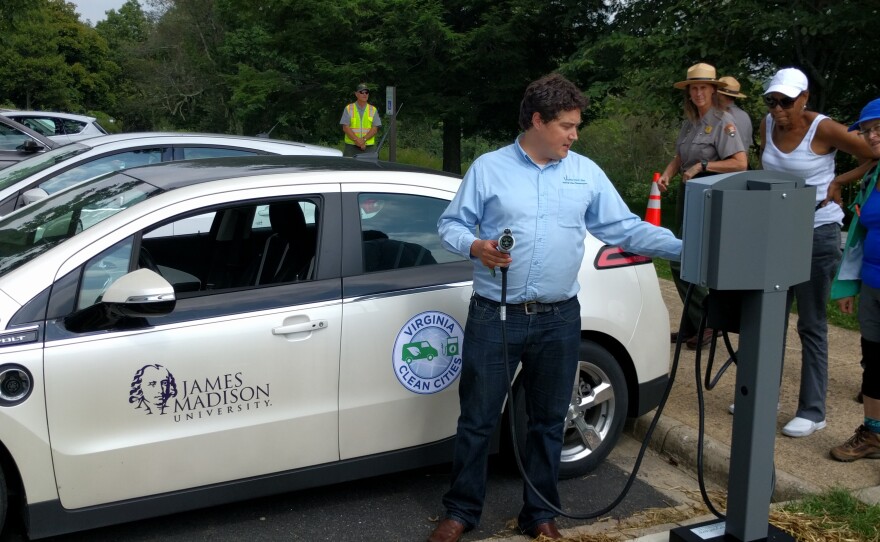If you build it, they will come. That’s the bet Shenandoah National Park is making with a new, fuel-efficient, addition to its ranks. WMRA’s Jordy Yager takes a look at the Park’s more climate friendly future.
[Sounds of wind, kids, cars]
It was a breezy and sunny August day atop Skyline Drive. Hundreds of cars pulled in and out of the parking lots at Big Meadows. Groups big and small, of all ages, from all over the world, milled about, getting directions for hikes, using restrooms, touring the Harry Byrd Visitor Center.
All, unsuspecting that the Shenandoah National Park had just struck a blow against one of its greatest foes.
JIM NORTHUP: Our charge from Congress is to manage these parks in such a way that they will remain unimpaired for the enjoyment of future generations and quite frankly we view climate change as the greatest threat to the integrity of the National Park System, and to the ecological integrity here at Shenandoah National Park.
Jim Northup is the superintendent of Shenandoah National Park and has been at the front of this charge — part of which includes cutting greenhouse gas emissions within the Park by 15 percent between now and 2020. Which is harder than it sounds. Sure, the famed Appalachian Trail runs through the park, but the overwhelming way that most of the 1.2 million annual visitors come to experience Shenandoah’s natural splendors? Yep, you guessed it.
[Sound of car starting]
Alleyn Harned is the executive director of Virginia Clean Cities.
ALLEYN HARNED: Virginia produces no oil, so every day that we’re buying somebody else’s oil, we’re spending more than $35 million that’s just leaving our economy, and that’s not very smart, but it’s also the number one contributing factor to climate change causing greenhouse gases of carbon dioxide here in Virginia.
Virginia Clean Cities is a statewide coalition based out of James Madison University that works towards improving air quality, promoting smart energy use, and helping to build alternative fuel infrastructure, such as the brand new electric vehicle charging station that’s brought Harned and Northup together on this Saturday afternoon at Big Meadows, for a ribbon cutting.
Standing before a small audience, they each hold a handle on a giant oversized pair of scissors. With a large bright green ribbon delicately balanced between its shears, they squeeze.
[Sound of ribbon cutting]
HARNED: One, two, three!
AUDIENCE: Alright — Applause — Bravo!
The charging station resembles a thinner, less complicated gas pump, and the parking space closest to the visitor center is reserved especially for electric vehicles. Of course, a glance around the parking lot tells you that gas powered cars still outnumber electric cars, by far, but that’s part of why charging stations are so essential, says Northup. You’re only going to drive to places where you know you can charge up so you can make it back home.
NORTHUP: We think we’ll see more and more electric cars here once people know that they can come here, recharge, go on a little hike, or sit down and have a meal, and then when they come back, their car’s charged up and they’re ready to go.
And those linkages are increasingly being made easier, says Harned, with distances between charging stations becoming shorter and shorter. In 2009, there were zero charging stations in Virginia, and today, seven years later? More than 500.
HARNED: We’ve installed some DC-fast chargers, so some electric vehicle infrastructure just up at the North end of the park, and now we have this here, and hopefully we can keep going down Skyline Drive on to the Blue Ridge Parkway. We’ve also installed some electric chargers down in Tennessee. So we’ve got a ways to go between chargers but this is still very significant infrastructure.
Harned says power plants in Virginia are reducing their dependence on big greenhouse gas emitters, with less than 17 percent of the state’s electricity coming from coal-fired plants this past year. So while it’s possible that the Park’s new charger gets some electricity from coal, the chances are small. And what’s more, an electric vehicle charging station means electric vehicles, which means fewer gas-powered cars, which means fewer greenhouse gas emissions actually in the park.
The charging station was made possible by a grant from the U.S. Department of Energy, and is part of a broader attempt to green the park. Northup says the park has 52 clean vehicles in use now, with more on the way. And it’s not just road vehicles.
NORTHUP: We were able to replace four greenhouse gas-emitting lawn mowers. We mow a lot of grass here at Shenandoah National Park and we were able to replace four of these zero turn lawnmowers with propane-powered lawnmowers, which are much cleaner.
Northup says the Park’s also looking to phase out many of the fuel oil furnace systems currently used to heat its older buildings, while also improving their insulation. And over the last year, the Big Meadows area revamped its parking lot lights, switching to solar power, while also making them night sky compliant to reduce the amount of light pollution for visitors.
There’s still a long way to go, says Northup, but the Park, established 80 years ago, is well on its way to becoming climate friendly.
NORTHUP: We have some really important stewardship responsibilities. And for many years we had to just deal with things that were occurring in the park, to protect the integrity of the park. But now we’re dealing with climate change and invasive species and air quality issues, and so this is a really important initiative for us here at Shenandoah National Park.



